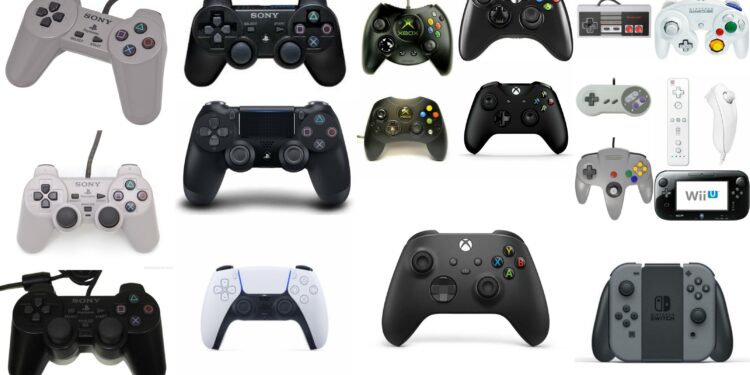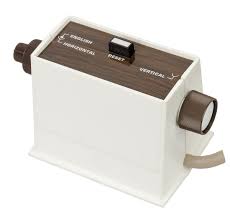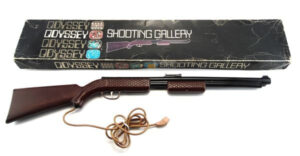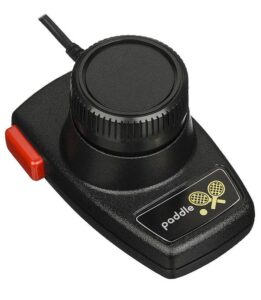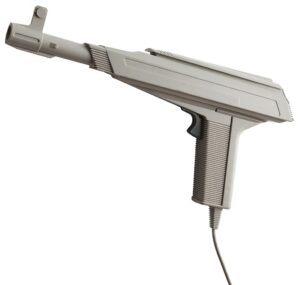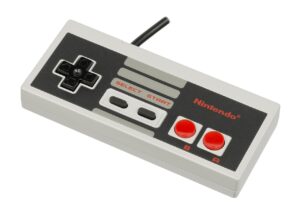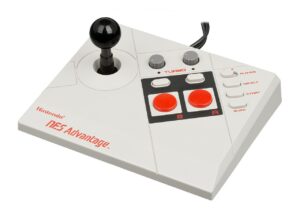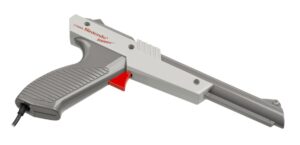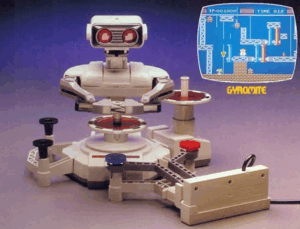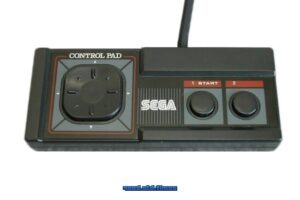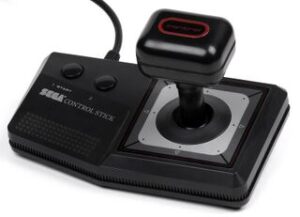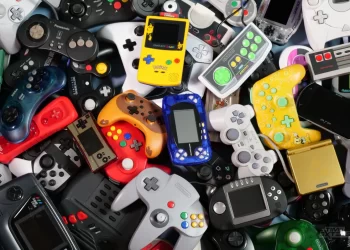By: Lennox
Accessories and Peripherals are of the utmost importance in the world of video games. They are what allow us to experience and engage in the virtual adventures we adore so much. With that being said, I would like to talk about just a select few of the controllers/accessories and peripherals that graced the first 3 generations of the video game world.
In the humble beginnings, the first generation gaming devices were basic, mainly using dials and buttons. One of the first and most notable to this early technology was the Magnovox Odyssey. The Odyssey used box-shaped controllers that had dials and buttons along the left and right upper sides of their controllers. The left dial is responsible for horizontal movements, with the right dial responsible for vertical movements. There was also a reset button directly on top of the controller itself. Though somewhat primitive, the controls proved quite adequate for the simplistic games the Odyssey had to offer. The Odyssey (believe it or not) had what would soon be one of the most popular of all video game peripherals: a gun. Known as the Light Rifle, which resembled an actual pump-action Remington rifle, allowed players to shoot a moving light target (with the aid of a plastic overlay) displayed on a television screen. The Light Rifle used a pump-action mechanism, responsible for reloading the firearm under spring tension. It also had a mild recoil and an audible sound when fired, giving the users a sense of realism.
Moving into the second generation, the Atari 2600, which of course needs no introduction, also utilized basic input controllers. One in the form of a joystick, the infamous CX10, which replaced the more expensive CX40. The detachable and cross-platformed CX10 was the standard for the Atari 8-bit computers and was compatible with the VIC-20, Commodore 64, Commodore 128, MSX, and later the Atari ST and Amiga. The joystick itself consisted of one button and an 8-directional stick. One other controller worth mentioning would be the Paddle controller. This controller included one red button and a round wheel that was typically used to control the movement of the player or object along one axis of the video screen. The paddle controller rotated through a fixed 330-degree arc with a stop at each end. For some, it is affectionately known as the Pong and or Breakout controller. Another controller available at the time was the driving controller, which was extremely similar to the paddle controller except for the fact that the control wheel rotated 360 degrees to emulate steering wheel controls.
Atari was also packing with their own form of a gun known as the XG-1 light gun, which was compatible with the Atari 8-bit computers, Atari 7800, and Atari 2600. Released in 1987, this piece of hardware was bundled with the Atari XEGS Deluxe home computer and video game console combination system. The system also came with Bug Hunt, which was a game specifically made for use with the light gun. The XG-1 was a specialized light pen. Since Atari had generic light pen support built into the Atari 8-bit home computers back in 1979, it made sense to use that technology for the light gun itself (talk about thinking ahead). Since light pen technology was used, it was recommended that a calibration procedure be done each time the light pen/gun was used, so that the software can compensate for this offset for maximal accuracy.
As the third generation rolled around, no gaming console stood out more than the Nintendo Entertainment System. The NES (for short) introduced a pivotal design to its controllers that became an industry standard. That design was known as the directional pad, aka the D-pad. The D-pad was a flat, cross-shaped surface designed to translate thumb movement into directional control. The controllers as a whole were rectangular in shape with a brick-like design that consisted of two round buttons labeled “B” and “A”, a “START” button, and a “SELECT” button. The NES controller was designed to replace bulkier joysticks used by earlier gaming consoles. The controllers were detachable and could also be unplugged from the NES console, which featured two custom 7-pin ports on the front of the console (unlike the Japanese Famicom) that had built-in controllers; one featuring a mic for voice input. The NES didn’t stop there, though, when it came to game controllers. Another one worth mentioning is the NES Advantage, which was far larger, bulkier, and featured a joystick, bigger buttons, and turbo features. It was designed to simulate the look and feel of cabinet arcade game controls with the idea to make gaming at home feel more like gaming in a video arcade.
The NES was no stranger to the peripheral, as it had plenty to boot. The most popular being the NES Zapper. The Zapper was Nintendo’s equivalent of a light gun accessory. Designed after Gunpei Yokoi‘s Video Shooting Series light gun, which had been released in Japan for the Famicom on February 18, 1984. The Zapper’s operation went as follows. When the trigger is pressed, the compatible game causes the entire screen to become black for one frame. Then, on the next frame, all valid targets that are on screen are drawn as a white rectangle, as the rest of the screen remains black. The Zapper detects this change in light level and if any of the targets are in its hit zone. If targets were hit, the game determined which one was hit based on the time of the flash, as each target flashes for one video frame, one after another. The Zapper was included in what was known as the NES bundle, which also came with the robot toy accessory R.O.B. (Robotic Operating Buddy). The NES focused on R.O.B. to further reclassify the system as a uniquely sophisticated toy experience instead of simply as a video game console. Both accessories were key to the identity of the NES’s 1985–1986 launch into the North American toy market instead of into the crashed video game market of 1983.
The NES went on to be a massive success, and believe it or no,t it had some slight competition. Enter the SEGA Master System. The SMS was originally a remodeled export version of the Sega Mark III. It was released just a few months after the NES in North America. Like the NES, the SMS had several accessories of its own. First up, the controllers. The SMS controllers consisted of a rectangle with a D-pad and two buttons labeled 1 and 2; the 1 button also acted as the start button. The D-pad itself was a square shape that allowed the player’s thumb to move smoothly over it. A paddle controller was also released for SMS, along with a controller that had a combination of a steering wheel and a flight stick. Sega also made its own version of an arcade controller known as the Control Stick. The layout of the Control Stick had its joystick designed for right-handed control, instead of the typical left-handed setup with 2 buttons on the top left side of the base. The top of the stick itself also featured a rectangular handle as opposed to the usual round handle.
The Sega Master System like its predecessors, had a gun accessory known as the Light Phaser. It was released alongside the Master System in the US in 1986, and also saw a release in Europe, Brazil, and South Korea. The Light Phaser was a plastic gun consisting of a light sensor at the tip of the barrel, which focused on a small area of the screen, and a trigger. When the trigger is pulled, a compatible game flashes the screen in a way that is detectable by the light sensor, and hardware built into the console allows the game to determine where the gun is pointing. The Light Phaser, unlike the Nintendo Zapper, was a bit heavier and known to have more accurate targeting with a more responsive trigger. One last accessory available on the SMS I’d like to mention would be the SegaScope 3D Glasses. The accessory created the illusion of three-dimensional graphics in compatible games. The 3D illusion was created by using a shutter system that closed the left and right lenses rapidly. The SegaScope included a 3-D adapter that the glasses plugged into with a mic line-in. The adapter itself plugged directly into the card port of the SMS. The SegaScope worked relatively well, minus a slight disadvantage that halved the effective frame-rate, which some users can perceive as flicker.
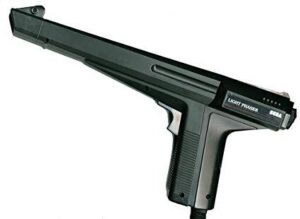
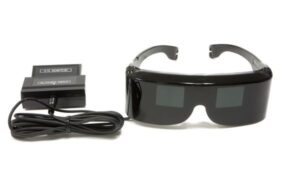
Though I merely grazed over just a few, one can see that in the first three generations alone, gaming accessories and peripherals spanned from basic input devices like joysticks and buttons to more elaborate peripherals like light guns, at-home arcade controllers, and even specialized equipment like robots and 3D glasses. From the early iterations that focused on providing inputs of the most basic nature to the later ones that began to/sought to enhance the gaming experience through novelty, customization, and new developments in technology; all were truly innovative and paved the way for the accessories today and the ones we will soon enjoy for generations to come. Game on!


 NFL
NFL